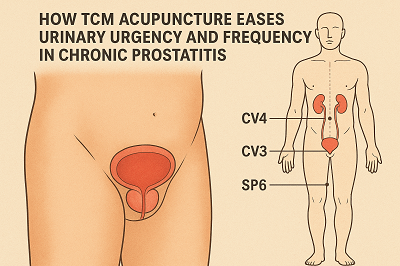How TCM Acupuncture Eases Urinary Urgency and Frequency in Chronic Prostatitis
In traditional Chinese medicine (TCM) theory, lower urinary tract symptoms of chronic prostatitis are mostly related to factors such as insufficient kidney qi, dysfunction of bladder qi transformation, and stagnation of qi and blood. For treatment, in addition to using a series of Chinese herbal medicines like Diuretic and Anti-inflammatory Pill, we can also adopt acupuncture therapy.

As a traditional TCM treatment, acupuncture stimulates specific acupoints to regulate qi and blood and unblock meridians, thereby alleviating symptoms. Its therapeutic mechanism includes the synergistic effect of acupoints, multi-channel action modes, and clear clinical application value.
Analysis of Common Acupoints and Their Effects
Guanyuan (CV4)
Location: 3 cun below the navel, an important acupoint of the Ren Meridian.
Effect: Guanyuan is known as the "root of primordial qi". It can nourish primordial qi and promote urination. From a TCM perspective, primordial qi is the motive force of life activities. Acupuncture at Guanyuan can stimulate primordial qi, regulate the qi transformation function of the bladder, ensure proper opening and closing of the bladder, and thus relieve discomfort such as frequent urination and urgency. In clinical practice, this acupoint is often used as a core acupoint for lower urinary tract symptoms caused by primordial qi deficiency.
Zhongji (CV3)
Location: 4 cun below the navel, an important acupoint of the Ren Meridian.
Effect: Zhongji is adjacent to the bladder and is a key acupoint for regulating urinary system function. It can directly act on the bladder. After acupuncture, it can improve the contractile function of bladder smooth muscle, enhance the bladder's urine storage and urination capacity, and effectively reduce symptoms such as frequent urination and urgency. For lower urinary tract problems caused by bladder dysfunction, the regulatory effect of Zhongji is particularly significant.
Qihai (CV6)
Location: 1.5 cun below the navel, an important acupoint of the Ren Meridian.
Effect: Qihai is known as the "sea of qi". It has the functions of tonifying middle qi and strengthening the body's resistance to pathogenic factors. TCM believes that sufficient qi and blood ensure normal bodily functions. Acupuncture at Qihai can replenish the body's healthy qi, enhance immunity, and improve the body's ability to fight against pathogenic factors, thereby alleviating lower urinary tract symptoms. For patients with weak constitution and insufficient healthy qi, this acupoint can have a good auxiliary therapeutic effect.
Sanyinjiao (SP6)
Location: On the medial side of the lower leg, 3 cun above the tip of the medial malleolus, behind the medial border of the tibia. It is the intersection point of the three yin meridians of the foot (Spleen Meridian, Liver Meridian, and Kidney Meridian).
Effect: These three meridians are closely related to the urogenital system. Sanyinjiao regulates the qi and blood of the Liver, Spleen, and Kidney Meridians, thereby regulating the water metabolism of the bladder. The liver governs dispersion and discharge, the spleen governs transportation and transformation, and the kidney governs water.
When the qi and blood of these three meridians are harmonized, the water metabolism of the bladder is normal, and lower urinary tract symptoms are naturally alleviated. This acupoint has a significant effect on lower urinary tract symptoms caused by disorders of the liver, spleen, and kidney.
Shenshu (BL23)
Location: On the lower back, 1.5 cun lateral to the lower border of the spinous process of the 2nd lumbar vertebra, an important acupoint of the Bladder Meridian of Foot-Taiyang.
Effect: Shenshu is the back-shu acupoint of the kidney and can directly regulate kidney function. TCM holds that "the kidney governs water", and normal kidney function ensures smooth water metabolism. Acupuncture at Shenshu can improve the qi and blood circulation of the urogenital system, have a good conditioning effect on urogenital system diseases such as chronic prostatitis, and thus alleviate lower urinary tract symptoms.
Yinlingquan (SP9)
Location: On the medial side of the lower leg, in the depression between the inferior border of the medial condyle of the tibia and the medial border of the tibia, an important acupoint of the Spleen Meridian of Foot-Taiyin.
Effect: The spleen governs the transportation and transformation of water and dampness. As an important acupoint of the Spleen Meridian, Yinlingquan has a strong effect of promoting diuresis and smoothing urination. It can promote the metabolism of water and dampness, reduce the burden on the bladder, and improve bladder function. It has a good relieving effect on lower urinary tract symptoms such as incomplete urination caused by internal retention of water and dampness.
Core Mechanisms of Acupuncture's Effect
Regulating Nerve Function
The autonomic nervous system plays an important role in regulating bladder sensitivity. When the autonomic nervous system is disordered, the bladder is prone to hypersensitivity, leading to frequent urination and urgency. Acupuncture can regulate the balance of the autonomic nervous system by stimulating acupoints, reduce bladder hypersensitivity, and restore the normal sensory and motor functions of the bladder.
Improving Microcirculation
The microcirculation of the prostate and bladder is closely related to the occurrence and development of inflammation. Poor microcirculation can lead to the accumulation of inflammatory substances and aggravate symptoms. Acupuncture can dilate local blood vessels, increase blood flow, improve the microcirculation of the prostate and bladder, promote the absorption and excretion of inflammatory factors, and create a good environment for tissue repair.
Anti-Inflammatory Effect
The immune system is the body's natural barrier against inflammation. Acupuncture can regulate the function of the immune system, enhance the activity of immune cells, and inhibit the release of inflammatory mediators, thereby reducing the inflammatory response of the prostate and bladder and fundamentally relieving lower urinary tract symptoms caused by inflammation.
Analgesic Mechanism
Patients with chronic prostatitis are often accompanied by pain in the lower abdomen, perineum, and other parts. Acupuncture exerts analgesic effects through multiple pathways: first, it reduces the conduction speed of pain signals and slows down the sense of pain; second, it optimizes the brain's perception of pain and reduces the discomfort of pain; third, it weakens the inflammatory response and reduces the inducing factors of pain. The combination of multiple mechanisms effectively relieves chronic pain.
Clinical Application and Advantages
Comprehensive Regulation
The six acupoints (Guanyuan, Zhongji, Qihai, Sanyinjiao, Shenshu, and Yinlingquan) play roles from different angles: Guanyuan and Qihai nourish primordial qi and strengthen physical fitness; Zhongji and Yinlingquan regulate the bladder and promote urination; Sanyinjiao and Shenshu regulate zang-fu organs and harmonize qi and blood. They work together to form a complete treatment system, which has a definite effect on relieving lower urinary tract symptoms of chronic prostatitis and can effectively improve patients' quality of life.
Support from Modern Research
Modern medical research has confirmed the effectiveness of acupuncture in treating chronic prostatitis through clinical trials and mechanism exploration. Studies have found that the analgesic mechanism and immune response mechanism of acupuncture play important roles in treatment, and its efficacy has been systematically and comprehensively evaluated. At the same time, studies have shown that acupuncture treatment has the advantages of few side effects and good patient tolerance, providing a strong scientific basis for clinical application.
Precautions
Acupuncture treatment must be performed by professional physicians, who will formulate personalized treatment plans according to the patient's specific condition and constitution. During treatment, patients should pay attention to rest, avoid sitting for a long time and overworking, and maintain good living habits to enhance the therapeutic effect. In addition, acupuncture treatment needs to be carried out in courses, and patients should adhere to the treatment and not give up halfway.
In conclusion, acupuncture treatment for lower urinary tract symptoms of chronic prostatitis, with its clear acupoint effects, scientific action mechanisms, and reliable clinical effects, has become a treatment method worthy of promotion. With the deepening of modern research, its therapeutic mechanism will be more clearly explained, bringing benefits to more patients.



